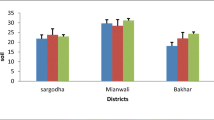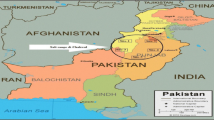Summary
A systematic mapping technique based on blood, forage and soil selenium levels was employed to locate areas of selenium deficiency, adequacy or excess in areas of Kenya where grazing of small ruminants predominates. A total of 1,478 blood samples from both sheep and goats, 180 forage samples and 90 soil samples were analysed for selenium levels. During the wet seasons 28% of the sheep and 15% of the goats had marginal to deficient blood selenium concentrations while during the dry season 20% of the sheep and 12% of the goats had marginal to deficient blood selenium concentrations. Forage samples had a range of 0·03 to 0·66 ppm selenium while soil samples had a range of 0·06 to 0·98 ppm selenium. Although many animals had blood selenium levels of less than 0·05 ppm, below which selenium deficiency signs might occur, none of the animals manifested these signs.
Résumé
Une technique de cartographie systématique basée sur les taux de sélénium dans le sang, les fourrages et le sol a été utilisée pour localiser les réunions où existent une carence, une adéquation ou un excès de sélénium dans les parties du Kenya où prédomine l’élevage des petits ruminants. 1478 échantillons de sang de moutons et de chèvres, 180 de fourrages et 90 de sol ont été analysés pour leur teneur en sélénium. Pendant la saison des pluies, 28 p. 100 des moutons et 15 p. 100 des chèvres ont des teneurs sanguines limites à déficientes tandis qu’en saison sèche ce ne sont que 20 p. 100 des moutons et 12 p. 100 des chèvres qui ont des teneurs limites à déficientes. Les échantillons de fourrages varient en concentration de sélénium de 0,03 à 0,66 ppm et les échantillons de sol de 0,06 à 0,98 ppm. Bien que beaucoup d’animaux présentent des taux sanguins inférieurs à 0,05 ppm, seuil en dessous duquel des signes de carence en sélénium peuvent se rencontrer, aucun animal n’a montré de tels signes.
Resumen
Se utilizó una técnica sistematizada para definir mediante análisis sanguíneos, de forraje y suelos, las áreas con cantidades adecuadas, deficientes y en exceso de selenio. Todas las áreas estudiadas fueron destinadas al pastoreo de pequeños rumiantes. Se examinaron un total de 1478 muestras de sangre, 180 de forraje y 90 de suelos. Durante las estaciones lluviosas, 28% de las ovejas y 15% de las cabras presentaron deficiencias marginales y pronunciadas de selenio en la sangre, mientras que en la estación seca las deficiencias se presentaron en el 20% de ovejas y en el 12% de cabras. Las muestras de forraje tuvieron un rango de 0·03 a 0·66 ppm de selenio, mientras que el rango de selenio en las muestras de suele varió entre 0·06 y 0·98 ppm. Aunque muchos animales presentaron niveles sanguíneos por dabajo de 0·05 ppm, ninguno mostró síntemas de deficiencia en selenio.
Similar content being viewed by others
References
Bergh, H., Woien, T. &Aasehaug, B. (1973).Nordish Veterinary Medicine,25, 521–527.
Blood, D. C., Henderson, J. A. &Radostttis, O. M. (1980).Veterinary Medicine, 5th edn, Bailliere Tindall, London.
Cox, D. H. &Bibb, A. E. (1981).Journal of Association of Official Analytical Chemists,64, 2, 265–269.
Floslie, A., Ulvund, M. J., Maina, J. N. &Norheim, G. (1983).Nordic Veterinary Medicine,35, 209–212.
Hopkins, L. L., Pope, A. L. &Barmann, C. A. (1964).Journal of Animal Science,23, 674–681.
Inhat, M. &Miller, H. J. (1977).Journal of Association of Official Analytical Chemists,60, 813.
Lakin, H. W. (1961).Selenium in Nutrition, (Ed. J. E. Oldfield), National Academy of Science, Washington, D. C.
Schwarz, K. &Foltz, C. M. (1957).Journal of American Chemical Society,79, 3292.
Scott, M. L. (1973).Journal of Nutrition,103, 1502–1511.
SR-CRSP Report (1984). A survey of the physical and health condition of sheep and goats on related small subsistence farms in Western Kenya. SR-CRSP Technical Report No 25, Pullman, Washington State University, (Eds. F. Abinanti et al.).
Steel, R. G. D. & Torrie, J. H. (1980).Principles and procedures of statistics, a biometrical approach, 2nd edn. McGraw-Hill Book Company.
Underwood, E. J. (1980).Trace minerals in human and animal nutrition. 4th edn, Academic Press, New York pp. 302–346. United States National Research Council (1980). Mineral Tolerance of Domestic Animals. National Academy of Sciences, Washington, DC.
Author information
Authors and Affiliations
Rights and permissions
About this article
Cite this article
Mbwiria, S.K., Dickinson, J.O. & Bell, J.F. Blood selenium concentrations of sheep and goats from selected areas of Kenya. Trop Anim Health Prod 18, 159–165 (1986). https://doi.org/10.1007/BF02359528
Accepted:
Issue Date:
DOI: https://doi.org/10.1007/BF02359528




